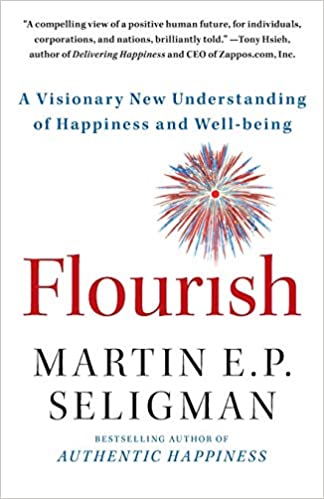Flourish by Martin Seligman Book Summary
The Book in 1 Sentences
Flourish: A Visionary New Understanding of Happiness and Well-being
“This book will help you flourish.
There, I have finally said it.
I have spent my professional life avoiding unguarded promises like this one. I am a research scientist, and a conservative one at that. The appeal of what I write comes from the fact that it is grounded in careful science: statistical tests, validated questionnaires, thoroughly researched exercises, and large, representative samples. In contrast to pop psychology and the bulk of self-improvement, my writings are believable because of the underlying science.”
~ Martin Seligman
9 BIG Ideas
Flourish by Martin Seligman Summary
1. Well-being Vs Authentic Happiness Theory
“I used to think that the topic of positive psychology was happiness, that the gold standard
for measuring happiness was life satisfaction, and that the goal of positive psychology was to
increase life satisfaction.
I now think that the topic of positive psychology is well-being, that the gold standard for measuring well-being is flourishing, and that the goal of positive psychology is to increase flourishing.
This theory, which I call well-being theory, is very different from authentic happiness theory, and the difference requires explanation.”
So, Authentic Happiness Theory:
Topic: happiness
Measure: life satisfaction
Goal: increase life satisfaction
Well-Being Theory:
Topic: well-being
Measures: positive emotion, engagement, meaning, positive relationships, and accomplishment
Goal: increase flourishing by increasing positive emotion, engagement, meaning, positive relationships, and accomplishment
“The entire thrust of this book is that optimal performance is tied to good well-being; the higher the positive morale, the better the performance.”
“The goal of positive psychology in well-being theory... is to increase the amount of *flourishing* in your own life and on the planet.”
2. Well-being theory (PERMA)
“Here then is well-being theory: well-being is a construct; and well-being, not happiness, is the topic of positive psychology. Well-being has five measurable elements (PERMA) that count toward it:
• Positive emotion (of which happiness and life satisfaction are all aspects)
• Engagement
• Relationships
• Meaning
• Achievement
No element defines well-being, but each contributes to it.”
3. The strengths and virtues
“In authentic happiness theory, the strengths and virtues—kindness, social intelligence, humor, courage, integrity, and the like (there are twenty-four of them)—are the supports for engagement. You go into flow when your highest strengths are deployed to meet the highest challenges that come your way.
In well-being theory, these twenty-four strengths underpin all five elements, not just engagement: deploying your highest strengths leads to more positive emotion, to more meaning, to more accomplishment, and to better relationships.”
Go to www.authentichappiness.sas.upenn.edu and take the “VIA Survey of Character Strengths” test..
4. What went well today and why?
“Every night for the next week, set aside ten minutes before you go to sleep. Write down three things that went well today and why they went well.
You may use a journal or your computer to write about events, but it is important that you have a physical record of what you wrote. The three things need not be earthshaking in importance (“My husband picked up my favorite ice cream for dessert on the way home from work today”), but they can be important (“My sister just gave birth to a healthy baby boy”).
Next to each positive event, answer the question “Why did this happen?” For example, if you wrote that your husband picked up ice cream, write “because my husband is really thoughtful sometimes” or “because I remembered to call him from work and remind him to stop by the grocery store.” Or if you write, “My sister gave birth to a healthy baby boy,” you might pick as the cause “God was looking out for her” or “She did everything right during her pregnancy.”
Writing about why the positive events in your life happened may seem awkward at first, but please stick with it for one week. It will get easier. The odds are that you will be less depressed, happier, and addicted to this exercise six months from now.”
5. Kindness exercise
“We scientists have found that doing a kindness produces the single most reliable momentary increase in well-being of any exercise we have tested...
Here is the exercise: find one wholly unexpected kind thing to do tomorrow and just do it. Notice what happens to your mood.”
6. Dealing with it!
“Think about Abraham Lincoln and Winston Churchill, two severe depressives. They were both enormously well-functioning human beings who dealt with their “black dogs” and their suicidal thoughts. (Lincoln came close to killing himself in January 1841.)
Both learned to function extremely well even when they were massively depressed. So one thing that clinical psychology needs to develop in light of the heritable stubbornness of human pathologies is a psychology of “dealing with it.”
We need to tell our patients, “Look, the truth is that many days—no matter how successful we are in therapy—you will wake up feeling blue and thinking life is hopeless. Your job is not only to fight these feelings but also to live heroically: functioning well even when you are very sad.””
“Self-discipline outpredicts IQ for academic success by a factor of 2.”
“By some estimates, depression is about ten times more common now than it was fifty years ago.”
David Reynolds -in his book Constructive Living- tells us: “The mature human being goes about doing what needs to be done regardless of whether that person feels great or terrible. Knowing that you are the kind of person with that kind of self- control brings all the satisfaction and confidence you will ever need. Even on days when the satisfaction and confidence just aren’t there, you can get the job done anyway.”
7. The ABC model
“First, students learn the ABC model: how beliefs (B) about an adversity (A)—and not the adversity itself—cause the consequent (C) feelings. This is a point of major insight for students: emotions don’t follow inexorably from external events but from what you think about those events, and you can actually change what you think.”
8. 10,000 hours of deliberate practice
“Ericsson has argued that the cornerstone of all high expertise is not God-given genius but deliberate practice: the amount of time and energy you spend in deliberate practice.
Mozart was Mozart not primarily because he had a unique gift for music but because from toddlerhood, he spent all his time using his gift. World-class chess players are not faster of thought, nor do they have unusually good memories for moves. Rather they have so much experience that they are vastly better at recognizing patterns in chess positions than lesser chess players—and this comes from the sheer amount of their experience.
World-class piano soloists log 10,000 hours of solo practice by age twenty, in contrast to 5,000 hours for the next level of pianist, and in contrast to 2,000 hours for merely serious amateur pianists.
The prototype of deliberate practice is one of Ericsson’s graduate students, Choa Lu, who holds the Guinness World Record for the amazing number of pi he memorized: 67,890! The advice that follows is straightforward: if you want to become world class at anything, you must spend 60 hours a week on it for ten years.
What determines how much time and deliberate practice a child is willing to devote to
achievement? Nothing less than her character.”
“If we want to maximize the achievement of children, we need to promote self-discipline. My favorite social psychologist, Roy Baumeister, believes it is the queen of all the virtues, the strength that enables the rest of the strengths.
There is, however, an extreme trait of self-discipline: GRIT. Indeed, Angela went on to explore grittiness, the combination of very high persistence and high passion for an objective.”
9. Optimists Vs Pessimists
“We wanted to find out who never became helpless, so we looked systematically at the way that the people whom we could not make helpless interpreted bad events. We found that people who believe that the causes of setbacks in their lives are temporary, changeable, and local do not become helpless readily in the laboratory.
When assailed with inescapable noise in the laboratory or with rejection in love, they think, It’s going away quickly, I can do something about it, and it’s just this one situation. They bounce back quickly from setbacks, and they do not take a setback at work home.
We call them optimists. Conversely, people who habitually think, It’s going to last forever, it’s going to undermine everything, and there’s nothing I can do about it, become helpless readily in the laboratory. They do not bounce back from defeat, and they take their marital problems into their jobs. We call them pessimists.”
Seligman -in his book Learned Optimism- says: “Learned helplessness is the giving up reaction, the quitting response that follows from the belief that whatever you do doesn’t matter.
Explanatory style is the manner in which you habitually explain to yourself why events happen. It is the great modulator of learned helplessness. An optimistic explanatory style stops helplessness, whereas a pessimistic explanatory style spreads helplessness.”
Seligman also says: “Unlike dieting, learned optimism is easy to maintain once you start. Once you get into the habit of disputing negative beliefs, your daily life will run much better, and you will feel much happier.”
Sonja Lyubomirsky - in The How of Happiness book - also says: “All that is required to become an optimist is to have the goal and to practice it. The more you rehearse optimistic thoughts, the more ‘natural’ and ‘ingrained’ they will become. With time they will be part of you, and you will have made yourself into an altogether different person.”
Seligman says: “We estimate that being in the upper quartile of optimism seems to have a beneficial effect on cardiovascular risk roughly equivalent to not smoking two packs of cigarettes daily.”
That was my QUICK summary of the great book Flourish by Martin Seligman. If you’re interested, get your copy. There is a HUGE amount of life-changing ideas in this book, and we’ve only touched on a tiny bit of it.
Buy The Book: Flourish by Martin Seligman

GET Blinkist 7 Days FREE Trial
3000+ Book Summaries
(Audio and Text)









